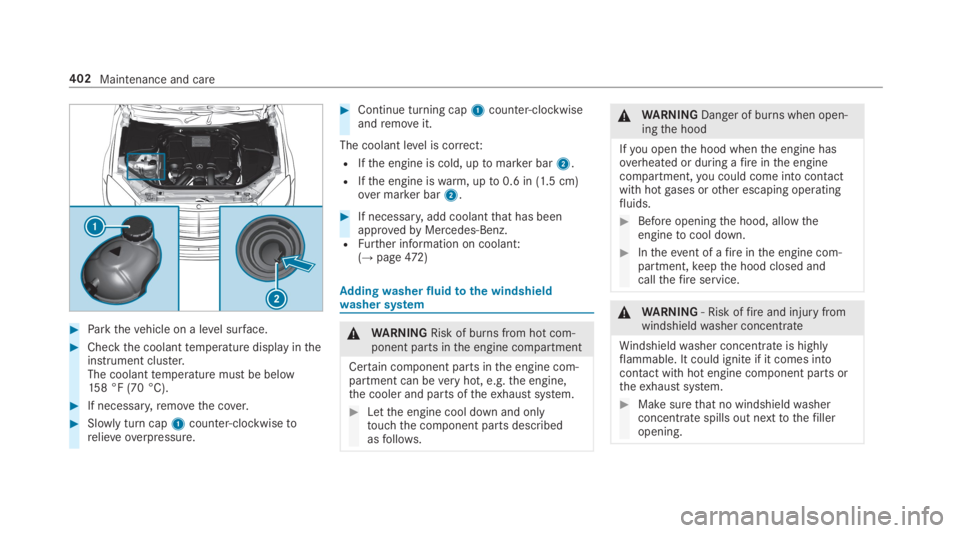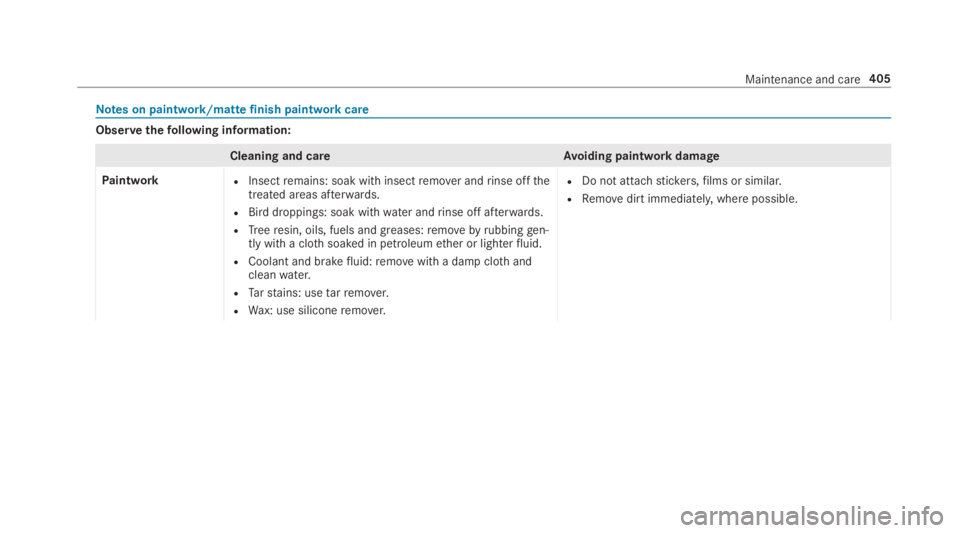2019 MERCEDES-BENZ S CLASS coolant
[x] Cancel search: coolantPage 253 of 578

Instrument Displayoverview
&WARNINGRisk of accident duetoaninstrument display malfunction
Ifthe Instrument Display hasfailed or mal‐functioned,you may notrecognize functionrestrictions applyingtosafetyrelevant sys‐tems.
The operating safety ofyourvehicle may beimpaired.
#Drive on carefully.
#Havethevehiclechecked immediatelyat aqualified specialistworkshop.
Mercedes‑AMGvehicles:observethe notes inthe Supplement. Otherwise,you mayfailtorec‐ognize dangers.
Plug-inhybrid:observethe notes inthe Supple‐ment. Otherwise,you mayfailtorecognize dan‐gers.
Ifthe operating safety ofyourvehicle isimpaired, parkthevehicle safely as soon as pos‐sible. Contact aqualified specialistworkshop.
Instrument Display
1Speedometer
2Multifunction display
3Tachometer
4Coolanttemperaturegauge
5Fuel level and fuelfillerflap location indica‐tor
%This display is anexample. Other displaysare possible instead oftachometer3.
The segments in speedometer1indicatethesystemstatusforthefollowing:
RCruise control (→page 200)
RActive Distance AssistDISTRONIC(→page203)
Vehicles withTraffic Sign Assist:Detectedinstructions and traffic signs will appear onthespeedometer (→page 239).
*NOTEEngine damageduetoexcessivelyhigh engine speeds
The engine will be damaged ifyou drive withthe engine intheoverrevvingrange.
#Do not drive with the engine intheover‐revvingrange.
Theoverrevvingrange is shown inred ontach‐ometer3. Whentheoverrevvingrange isreached,the fuel supply will be interruptedtoprotectthe engine.
During normal operating conditions, coolanttemperature display4mayriseto248 °F(120 °C).
Instrument Displayand on-board computer251
Page 403 of 578

#Followthe instructions inthe serviceinterval displayregardingthe oilchange.
*NOTEDamagecausedbyaddingtoomuch engine oil
Too much engine oil can damagethe engineorthe catalytic converter.
#Haveexcess engine oilremoved at aqualified specialistworkshop.
#Turncap1counter-clockwise andremoveit.
#Add engine oil.
#Replace cap1and turn it clockwise asfaras it will go.
#Checkthe oil level again (→page 399).
Checking coolant level
&WARNINGRisk of burns from hot com‐ponent parts inthe engine compartment
Certain components inthe engine compart‐ment can beveryhot, e.g.the engine,theradiator and parts oftheexhaust system.
#Allowthe enginetocool down and onlytouch component parts described inthefollowing.
&WARNINGRisk of scalding from hotcoolant
The engine cooling system is pressurized,particularly whenthe engine iswarm. Ifyouopenthe cap,you could be scaldedbyhotcoolant spraying out.
#Letthe engine cool down before open‐ingthe cap.
#When openingthe cap,wear protectivegloves and safetyglasses.
#Openthe cap slowlytorelease pres‐sure.
Maintenance and care401
Page 404 of 578

#Parkthevehicle on a level surface.
#Checkthe coolanttemperature display intheinstrument cluster.The coolanttemperature must be below158 °F (70 °C).
#If necessary,removethe cover.
#Slowly turn cap1counter-clockwisetorelieve overpressure.
#Continue turning cap1counter-clockwiseandremoveit.
The coolant level is correct:
RIfthe engine is cold, uptomarker bar2.
RIfthe engine iswarm, upto0.6 in (1.5 cm)over marker bar2.
#If necessary,add coolantthat has beenapprovedbyMercedes-Benz.RFurther information on coolant:(→page472)
Addingwasherfluidtothe windshieldwasher system
&WARNINGRisk of burns from hot com‐ponent parts inthe engine compartment
Certain component parts inthe engine com‐partment can beveryhot, e.g.the engine,the cooler and parts oftheexhaust system.
#Letthe engine cool down and onlytouchthe component parts describedasfollows.
&WARNINGDanger of burns when open‐ingthe hood
Ifyou openthe hood whenthe engine hasoverheated or during afireinthe enginecompartment,you could come into contactwith hotgases orother escaping operatingfluids.
#Before openingthe hood, allowtheenginetocool down.
#Intheevent of afireinthe engine com‐partment,keepthe hood closed andcallthefireservice.
&WARNING‑ Risk offireand injury fromwindshieldwasher concentrate
Windshieldwasher concentrate is highlyflammable. It could ignite if it comes intocontact withhot engine component parts ortheexhaust system.
#Make surethat no windshieldwasherconcentrate spills out nexttothefilleropening.
402Maintenance and care
Page 407 of 578

Notes on paintwork/mattefinish paintworkcare
Observethefollowing information:
Cleaning and careAvoiding paintwork damage
PaintworkRInsectremains: soak with insectremover andrinse offthetreated areas afterwards.
RBird droppings: soak withwater andrinse off afterwards.
RTreeresin, oils, fuels and greases:removebyrubbinggen‐tly witha clothsoaked in petroleumether or lighterfluid.
RCoolant and brakefluid:removewith a damp clothandcleanwater.
RTarstains: usetarremover.
RWax: use siliconeremover.
RDo not attachstickers,films or similar.
RRemovedirt immediately,where possible.
Maintenance and care405
Page 454 of 578

UniformTireQuality GradingStandards:auniformstandardtogradethequality of tireswithregardtotreadquality,tire traction andtemperaturecharacteristics. Thequality gradingassessment is madebythe manufacturerfollow‐ing specifications fromtheU.S. government. Thequalitygrade of a tire is imprinted onthe sidewall ofthe tire.
Recommended tire pressure:therecommen‐ded tire pressure isthe tire pressure specifiedforthe tires mountedtothevehicle atthefac‐tory.
The tire and informationtable containstherec‐ommended tire pressuresfor cold tires,the max‐imum permissible load andthe maximum per‐missiblevehicle speed.
The tire pressuretable containstherecommen‐ded tire pressuresfor cold tires undervariousoperating conditions, i.e. loading and/or speedofthevehicle.
Increasedvehicleweight duetooptionalequipment:the combinedweight of allstandardand optional equipmentavailableforthevehicle,
regardless of whether it is actually installed onthevehicle or not.
Rim:the part ofthe wheel on whichthe tire isinstalled.
GAWR (Gross AxleWeightRating):the GAWRisthe maximum permissible axle load. Theactual load on an axle must neverexceedthegrossaxleweightrating. The gross axleweightrating can befound onthevehicle identificationplate onthe B‑pillar onthe driver's side.
Speedrating:the speedrating is partofthe tireidentification. It specifiesthe speedrangeforwhich a tire is approved.
GVW (GrossVehicleWeight):the grossvehicleweight comprisestheweight ofthevehicleincluding fuel,tools,the spare wheel, accesso‐ries installed, occupants, luggage andthe trailerdrawbar noseweight, if applicable. Thegrossvehicleweight must notexceedthe grossvehicleweightratingGVWR as specified onthevehicleidentification plate onthe B‑pillar onthe driver'sside.
GVWR (GrossVehicleWeightRating):theGVWR isthe maximum permitted grossweight
ofthe fully ladenvehicle (weight ofthevehicleincluding all accessories, occupants, fuel, lug‐gageandthe trailer drawbar noseweight if appli‐cable). Thegrossvehicleweightrating is speci‐fied onthevehicle identification plate ontheB‑pillar onthe driver's side.
Maximumweight ofthe ladenvehicle:themaximumweight isthe sum ofthe curbweightofthevehicle,theweight ofthe accessories,themaximum load andtheweight of optional equip‐ment installed atthefactory.
Kilopascal (kPa):metric unitfor tire pressure.6.9 kPa correspondsto1 psi. Another unitfortire pressureis bar.100 kilopascal (kPa) equals1 bar.
Load index:in additiontothe load-bearingindex,the load index may also be imprinted onthe sidewall ofthe tire. This specifiesthe load-bearing capacity ofthe tire more precisely.
Curbweight:theweight of avehicle withstand‐ard equipment includingthe maximum capacityof fuel, oil and coolant. It also includesthe airconditioning system and optional equipment if
452Wheels and tires
Page 470 of 578

Operatingfluids
Notes on operatingfluids
Mercedes-AMGvehicles:observethe notes inthe Supplement. Otherwise,you mayfailtorec‐ognize dangers.
&WARNINGRisk of injuryfrom operatingfluids harmfulto your health
Operatingfluids may be poisonous and harm‐fulto your health.
#Observethetext onthe original con‐tainers when using,storing or disposingof operatingfluids.
#Alwaysstore operatingfluids sealed intheir original containers.
#Alwayskeepchildrenawayfrom operat‐ingfluids.
&WARNINGRisk offireorexplosion fromfuel
Fuels are highlyflammable.
#Fire, openflames, smoking and creationof sparksmust beavoided.
#Switchoffthe ignition and, ifavailable,thestationary heater, before and whilerefuelingthevehicle.
&WARNINGRisk of injuryfrom fuels
Fuels are poisonous and hazardousto yourhealth.
#Do not swallow fuel or let it come intocontact with skin,eyes or clothing.
#Do not inhale fuelvapor.
#Keepchildrenawayfrom fuel.
#Keep doors and windowsclosed duringtherefueling process.
Ifyou orother people come into contact withfuel, observethefollowing:
#Immediatelyrinse fuel offyour skin withsoap andwater.
#If fuel comes into contact withyoureyes, immediatelyrinsethemthor‐
oughly with cleanwater.Seek medicalattention immediately.
#Ifyou swallow fuel, seek medical atten‐tion immediately.Do not inducevomit‐ing.
#Change immediately out of clothingthathas come into contact withfuel.
+ENVIRONMENTALNOTEEnvironmentalpollution causedbyenvironmentally irre‐sponsible disposal
#Dispose of operatingfluids in an envi‐ronmentallyresponsible manner.
Operatingfluids includethefollowing:
RFuels
RLubricants
RCoolant
RBrakefluid
RWindshieldwasherfluid
RClimate control systemrefrigerant
468Technical data
Page 474 of 578

Mercedes‑MaybachCapacity
S 650 Mercedes-May‐bach11.1US qt(10.5 liters)
S 560 4MATICMercedes-Maybach9.5 US qt (9.0 liters)
Notes on brakefluid
Observethe notes on operatingfluids(→page 468).
&WARNINGRisk of an accident duetovapor pocketsforming inthe brake sys‐tem
The brakefluid constantly absorbs moisturefromthe air. This lowersthe boiling point ofthe brakefluid. Ifthe boiling point istoo low,vapor pockets mayforminthe brake systemwhenthe brakes are applied hard.
This causesthe braking effecttobeimpaired.
#Havethe brakefluidrenewed atthespecified intervals.
Havethe brakefluidregularlyreplaced at aqualified specialistworkshop.Only use brakefluid approvedbyMercedes-BenzaccordingtoMB-Freigabe or MB-Approval 331.0.
You can obtain further information on brakefluidinthefollowing places:
Rinthe Mercedes-Benz SpecificationsforOperating Fluids
-at http://bevo.mercedes-benz.com
-inthe Mercedes-Benz BeVo App
Rat aqualified specialistworkshop
Coolant
Notes on coolantObservethe notes on operatingfluids(→page 468).
&WARNING‑ Risk offireand injury fromantifreeze
If antifreeze comes into contact withhotcomponent parts inthe engine compart‐ment, it may ignite.
#Allowthe enginetocool down beforeadding antifreeze.
#Makesurethat no antifreeze spills outnexttothefiller opening.
#Thoroughly clean off any antifreezefrom component parts beforestartingthevehicle.
*NOTEDamagecausedbyincorrect cool‐ant
#Only add coolantthat has been pre‐mixed withtherequired antifreeze pro‐tection.
472Technical data
Page 475 of 578

Information on coolant isavailable atthefol‐lowing locations:
RInthe Mercedes-Benz SpecificationforOperating Fluids310.1
-Athttp://bevo.mercedes-benz.com
-Inthe Mercedes-Benz BeVo app
RAtaqualified specialistworkshop
*NOTEOverheating at high outsidetem‐peratures
If an inappropriate coolant is used,theengine cooling system is not sufficiently pro‐tected againstoverheating and corrosion athigh outsidetemperatures.
#Always use coolant approvedbyMercedes-Benz.
#Observethe instructions intheMercedes-Benz Specificationsfor Oper‐ating Fluids310.1.
Havethe coolantregularlyreplaced at aqualifiedspecialistworkshop.
The proportion of corrosion inhibitor/antifreezeconcentrate inthe engine cooling system shouldbe:
Ra minimum of 50% (antifreeze protectiondowntoapproximately -35 °F (-37 °C))
Ra maximum of 55% (antifreeze protectiondownto-49 °F (-45 °C))
Coolant capacity
SedanCapacity
S 450 4MATIC13.9 US qt(13.2 liters)
S 560 4MATIC15.0 US qt(14.2 liters)
Long wheelbasevehiclesCapacity
S 450 4MATIC
S 450
13.9 US qt(13.2 liters)
Allother models15.0 US qt(14.2 liters)
Mercedes‑MaybachCapacity
S 650 Mercedes-May‐bach16.9 US qt(16.0 liters)
S 560 4MATICMercedes-Maybach15.0 US qt(14.2 liters)
Notes on windshieldwasher fluid
Observethe notes on operatingfluids(→page 468).
&WARNING‑ Risk offireand injury fromwindshieldwasher concentrate
Windshieldwasher concentrate is highlyflammable. It could ignite if it comes intocontact withhot engine component parts ortheexhaust system.
#Make surethat no windshieldwasherconcentrate spills out nexttothefilleropening.
Technical data473